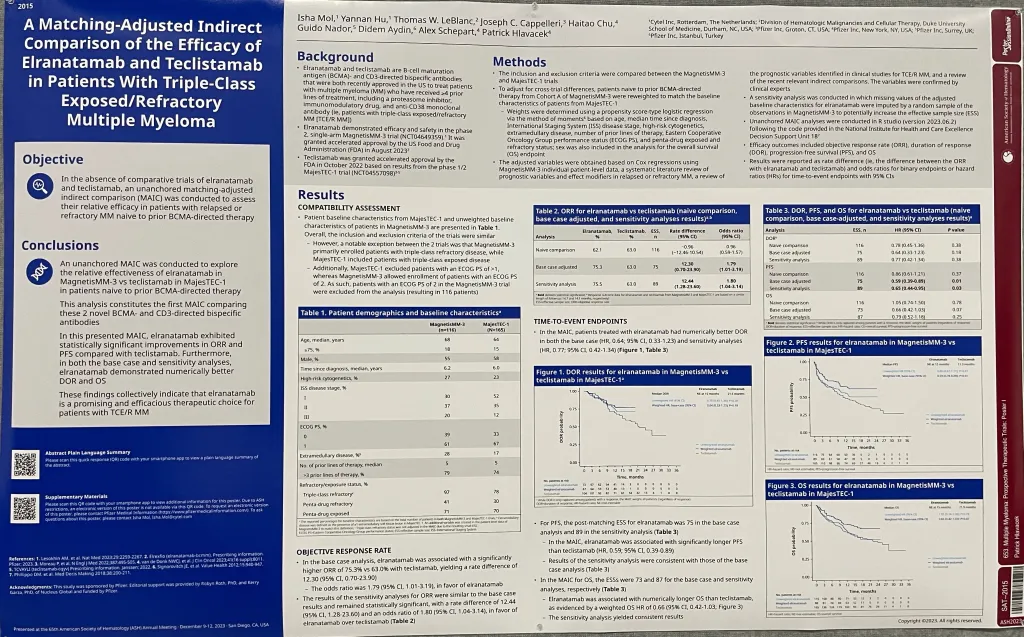ASH 2023: An Indirect Comparison of Elranatamab and Teclistamab

This study, presented at the ASH 2023 conference as a poster abstract, is a match-adjusted indirect evaluation for two FDA-approved novel B-cell maturation-antigen (BCMA) and CD3 bispecifics you may have heard good news about, elranatamab and teclistamab.
Information about Bispecific Antibody Therapy
As a reminder, the mechanism of action of bispecific antibody therapy is to grab a target protein on the myeloma cell, bind to a protein on the patient’s immune T-cell, and bring those two cells together to destroy the myeloma cell.
This specific study indirectly compared two bispecific antibody therapies, elranatamab and teclistimab, that both target a protein on the myeloma cell called "BCMA" as their mechanism of action.
This concept is explained in more detail in a video at HealthTree University here: Bispecific Antibody Therapy
In general, bispecific antibody therapy products have promising response rates but also have notable side effects like cytokine release syndrome, neurotoxicity, and the risk of serious infections.
Information about Elranatamab and Teclistimab
- Elranatamab was investigated in a study called the MagnetisMM-3 trial. There were 123 patients in this trial. Please see this HealthTree article for more details at this link: Elranatamab Approval
- Teclistamab was investigated in a study called the MajecTEC-1 trial. There were 165 patients in this trial. Please see this HealthTree article for more details at this link: Teclistamab Approval
Study Details
The goal of this assessment is to determine the better BCMA-CD3 targeting bispecific.
In this specific study, there was no direct one-on-one comparison. Rather, the investigators took two separate studies and mathematically adjusted the variables so they could make a more accurate comparison of the data that was gathered in these two separate studies.
The researchers matched the data as closely as possible by excluding patients who did not match the baseline of the other trial.
Using statistical analysis, to properly compare the two studies, the researchers adjusted the number of subjects for differences in:
- performance status
- age
- median time to diagnosis
- high-risk cytogenetics
- sex
- extramedullary disease
- number of prior lines of therapy
- penta-exposed /refractory status and
- International Staging System (ISS)
Personally, I found the author's statistical analysis difficult to follow based on the data presentation and visualizations provided in the article. At the conference, the author was not available to answer questions. Please see the poster presentation below.

While the data was hard to follow, we, as the myeloma community, need real-world data analysis to pinpoint the best in class in our growing arsenal of myeloma treatments.
I’m grateful to see that there is work being done in the field to use real-world data to compare bispecifics.
However, I believe in real-world data such as this, the comparison should be more transparent and easier to understand. In this study, based on the investigator's claims, the results seem promising for both bispecific antibodies, but one outperformed the other in this indirect comparison.
Before we reveal the winner of this BCMA boxing match, please remember the best way to evaluate products is in a direct comparison trial with matched sample sizes for each arm of the study.
Conclusion
In their conclusion, the researchers stated that “Elranatamab demonstrated significantly better overall response rate and progression-free survival than teclistamab.”
According to their analysis, the overall response rate of Elranatamab was 12.3% better than Teclistimab.
The progression-free survival was stated as a Hazard Ratio of .59 in the base case. Interpret this how you will (it was difficult for me, even with experience in statistics, to understand).
As myeloma patients, it is beneficial to discuss this information in detail with our myeloma specialists as both bispecific antibodies being compared in this trial have been FDA-approved and are available today.
In this study, this first-round win goes to elranatamab. Both elrantamab and teclistamab are excellent products and are worth discussing with your doctor as treatment options.
Let's keep our eye on the real-world data of these up-and-coming bispecific products.
ASH 2023 Resources
Would you like to watch ASH 2023 myeloma research interviews from the investigators themselves? Click "ASH 2023" here: HealthTree University Conference Coverage
To read other ASH 2023 articles, click here: HealthTree 2023 ASH Articles
This study, presented at the ASH 2023 conference as a poster abstract, is a match-adjusted indirect evaluation for two FDA-approved novel B-cell maturation-antigen (BCMA) and CD3 bispecifics you may have heard good news about, elranatamab and teclistamab.
Information about Bispecific Antibody Therapy
As a reminder, the mechanism of action of bispecific antibody therapy is to grab a target protein on the myeloma cell, bind to a protein on the patient’s immune T-cell, and bring those two cells together to destroy the myeloma cell.
This specific study indirectly compared two bispecific antibody therapies, elranatamab and teclistimab, that both target a protein on the myeloma cell called "BCMA" as their mechanism of action.
This concept is explained in more detail in a video at HealthTree University here: Bispecific Antibody Therapy
In general, bispecific antibody therapy products have promising response rates but also have notable side effects like cytokine release syndrome, neurotoxicity, and the risk of serious infections.
Information about Elranatamab and Teclistimab
- Elranatamab was investigated in a study called the MagnetisMM-3 trial. There were 123 patients in this trial. Please see this HealthTree article for more details at this link: Elranatamab Approval
- Teclistamab was investigated in a study called the MajecTEC-1 trial. There were 165 patients in this trial. Please see this HealthTree article for more details at this link: Teclistamab Approval
Study Details
The goal of this assessment is to determine the better BCMA-CD3 targeting bispecific.
In this specific study, there was no direct one-on-one comparison. Rather, the investigators took two separate studies and mathematically adjusted the variables so they could make a more accurate comparison of the data that was gathered in these two separate studies.
The researchers matched the data as closely as possible by excluding patients who did not match the baseline of the other trial.
Using statistical analysis, to properly compare the two studies, the researchers adjusted the number of subjects for differences in:
- performance status
- age
- median time to diagnosis
- high-risk cytogenetics
- sex
- extramedullary disease
- number of prior lines of therapy
- penta-exposed /refractory status and
- International Staging System (ISS)
Personally, I found the author's statistical analysis difficult to follow based on the data presentation and visualizations provided in the article. At the conference, the author was not available to answer questions. Please see the poster presentation below.

While the data was hard to follow, we, as the myeloma community, need real-world data analysis to pinpoint the best in class in our growing arsenal of myeloma treatments.
I’m grateful to see that there is work being done in the field to use real-world data to compare bispecifics.
However, I believe in real-world data such as this, the comparison should be more transparent and easier to understand. In this study, based on the investigator's claims, the results seem promising for both bispecific antibodies, but one outperformed the other in this indirect comparison.
Before we reveal the winner of this BCMA boxing match, please remember the best way to evaluate products is in a direct comparison trial with matched sample sizes for each arm of the study.
Conclusion
In their conclusion, the researchers stated that “Elranatamab demonstrated significantly better overall response rate and progression-free survival than teclistamab.”
According to their analysis, the overall response rate of Elranatamab was 12.3% better than Teclistimab.
The progression-free survival was stated as a Hazard Ratio of .59 in the base case. Interpret this how you will (it was difficult for me, even with experience in statistics, to understand).
As myeloma patients, it is beneficial to discuss this information in detail with our myeloma specialists as both bispecific antibodies being compared in this trial have been FDA-approved and are available today.
In this study, this first-round win goes to elranatamab. Both elrantamab and teclistamab are excellent products and are worth discussing with your doctor as treatment options.
Let's keep our eye on the real-world data of these up-and-coming bispecific products.
ASH 2023 Resources
Would you like to watch ASH 2023 myeloma research interviews from the investigators themselves? Click "ASH 2023" here: HealthTree University Conference Coverage
To read other ASH 2023 articles, click here: HealthTree 2023 ASH Articles

about the author
Beth Travis
Beth is a licensed Physical Therapist that truly believes in the benefits of exercise. Mother of two, a myeloma patient and advocate with a love of learning, healthy lifestyles and food adventures.
More on Conferences
Trending Articles




Get the Latest Multiple Myeloma Updates, Delivered to You.
By subscribing to the HealthTree newsletter, you'll receive the latest research, treatment updates, and expert insights to help you navigate your health.
Together we care.
Together we cure.
3x Faster.









